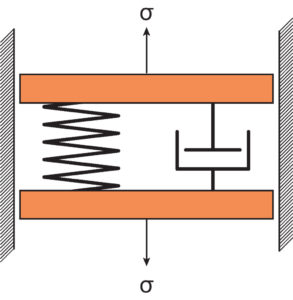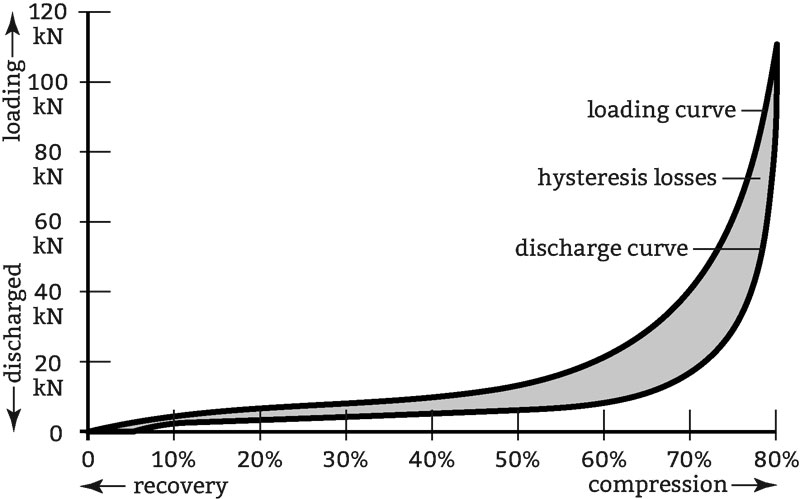Do you understand how hysteresis works? Let’s examine the compression-deflection curve for a given compound at a given shape factor and record the stress-strain relationship.
As the piece is loaded, we arrive at one reproducible curve after three or four cycles. Now, if we record the curve generated during the unloading we see that not all the initial energy is returned. The area under the loading curve can be called the input energy. The area under the return curve can be considered the return of stored energy and the area between the two curves is the energy that is not returned but is converted to heat. This energy is converted to heat by hysteresis. This phenomenon is characteristic of all types of rubber because rubber compounds are viscoelastic systems. See chart: stress-strain cycling of two 95A durometer urethanes.
The urethane elastomers consist of an elastic portion that stores energy and returns it and a viscous portion that captures the energy and converts it to heat. It might help to consider the spring and dashpot experiments of Physics class. The spring represents the elastic response and dashpot the viscous response.
 To some extent, the ratio of the elastic component to the viscous component can be altered by chemical manipulation during compounding, but both components are always present in a urethane compound. A high elastic to viscous ratio is common to highly resilient compounds. A low ratio is typical of a “dead” or low resilience compound. In design, the viscoelastic nature of urethanes must be taken into account. A low ratio compound converts more input energy to heat than a high ratio compound on each deflection cycle.
To some extent, the ratio of the elastic component to the viscous component can be altered by chemical manipulation during compounding, but both components are always present in a urethane compound. A high elastic to viscous ratio is common to highly resilient compounds. A low ratio is typical of a “dead” or low resilience compound. In design, the viscoelastic nature of urethanes must be taken into account. A low ratio compound converts more input energy to heat than a high ratio compound on each deflection cycle.
By the same token, if the frequency of deflection is very low, the low resilience compound will absorb more impact. This is an important consideration because excess heat is the Achilles Heel of polyurethane. The range of the coefficient of thermal conductivity (K) for polyurethanes is quite low, as you can see.
Approximately:

Due to the inherent low thermal conductivity of urethane and hysteretic heat build-up, part designers must address ways to generate less heat under cyclic loading conditions. This is typically accomplished by reducing the deflection (strain) per cycle, by increasing the compression modulus of the elastomer, or increasing the shape factor. Reducing the stress per unit area is another possible approach. The selection of compounds and stoichiometry coupled with design can alleviate many potential heat build-up problems.
Hysteresis is the time-based dependence of a system’s output on the present and past inputs.
A typical characteristic of polyurethane is its compression hardness. This is a measure of the resistance that the material exerts toward deformation. The hardness values at specific indentations can be derived from force-deflection diagrams. Loading and unloading curves together describe a hysteresis area.
The shape of the loading curve and the hysteresis area are a measure of the resiliency – energy absorption – of the polyurethane. The smaller the area, (between the loading and unloading curves), the higher is the resiliency. For products with large energy absorption and high damping behavior, a larger hysteresis area is characteristic.
(information obtained from Günter Oertel, Polyurethane Handbook Second Edition)

Do you understand how hysteresis works? Let’s examine the compression-deflection curve for a given compound at a given shape factor and record the stress-strain relationship.
As the piece is loaded, we arrive at one reproducible curve after three or four cycles. Now, if we record the curve generated during the unloading we see that not all the initial energy is returned. The area under the loading curve can be called the input energy. The area under the return curve can be considered the return of stored energy and the area between the two curves is the energy that is not returned but is converted to heat. This energy is converted to heat by hysteresis. This phenomenon is characteristic of all types of rubber because rubber compounds are viscoelastic systems. See chart: stress-strain cycling of two 95A durometer urethanes.
The urethane elastomers consist of an elastic portion that stores energy and returns it and a viscous portion that captures the energy and converts it to heat. It might help to consider the spring and dashpot experiments of Physics class. The spring represents the elastic response and dashpot the viscous response.
 To some extent, the ratio of the elastic component to the viscous component can be altered by chemical manipulation during compounding, but both components are always present in a urethane compound. A high elastic to viscous ratio is common to highly resilient compounds. A low ratio is typical of a “dead” or low resilience compound. In design, the viscoelastic nature of urethanes must be taken into account. A low ratio compound converts more input energy to heat than a high ratio compound on each deflection cycle.
To some extent, the ratio of the elastic component to the viscous component can be altered by chemical manipulation during compounding, but both components are always present in a urethane compound. A high elastic to viscous ratio is common to highly resilient compounds. A low ratio is typical of a “dead” or low resilience compound. In design, the viscoelastic nature of urethanes must be taken into account. A low ratio compound converts more input energy to heat than a high ratio compound on each deflection cycle.
By the same token, if the frequency of deflection is very low, the low resilience compound will absorb more impact. This is an important consideration because excess heat is the Achilles Heel of polyurethane. The range of the coefficient of thermal conductivity (K) for polyurethanes is quite low, as you can see.
Approximately:

Due to the inherent low thermal conductivity of urethane and hysteretic heat build-up, part designers must address ways to generate less heat under cyclic loading conditions. This is typically accomplished by reducing the deflection (strain) per cycle, by increasing the compression modulus of the elastomer, or increasing the shape factor. Reducing the stress per unit area is another possible approach. The selection of compounds and stoichiometry coupled with design can alleviate many potential heat build-up problems.
Hysteresis is the time-based dependence of a system’s output on the present and past inputs.
A typical characteristic of polyurethane is its compression hardness. This is a measure of the resistance that the material exerts toward deformation. The hardness values at specific indentations can be derived from force-deflection diagrams. Loading and unloading curves together describe a hysteresis area.
The shape of the loading curve and the hysteresis area are a measure of the resiliency – energy absorption – of the polyurethane. The smaller the area, (between the loading and unloading curves), the higher is the resiliency. For products with large energy absorption and high damping behavior, a larger hysteresis area is characteristic.
(information obtained from Günter Oertel, Polyurethane Handbook Second Edition)

